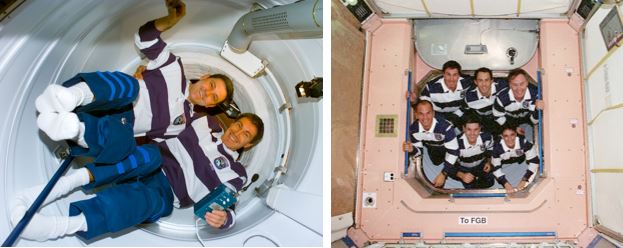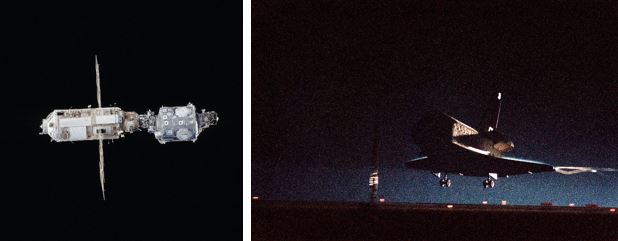The first Space Shuttle mission to the International Space Station (ISS), STS-88 made a spectacular night launch on Dec. 4, 1998, just two weeks after the Russian-built module Zarya made it safely to orbit. Aboard Endeavour was its six-person crew led by veteran astronaut Robert D. Cabana. The pilot for the mission was first-time space flier Frederick W. “Rick” Sturckow, and the four mission specialists were veterans Jerry L. Ross and Nancy J. Currie, rookie James H. Newman, and from the Russian Space Agency, Sergey K. Krikalev. Their mission: to deliver the Unity Node 1 module, the first U.S.-built element of the ISS, and join it with Zarya to complete the first step in the assembly of the orbiting research laboratory.
To complete the first major task of the mission, Currie used the Shuttle’s robotic arm to unberth Unity from its cradle in the rear of Endeavour’s payload bay and move it to just above the Orbiter Docking System. Cabana then fired the Shuttle’s thrusters to complete the docking of Unity. The following day, Cabana guided Endeavour to within the arm’s reach of Zarya and Currie then grappled the Russian module and brought it to just above Unity’s berthing port. Repeating the previous day’s action, Cabana fired the Shuttle’s thrusters and Zarya and Unity were physically mated.
On Dec. 7, Ross and Newman stepped out of Endeavour’s airlock to begin the mission’s first of three Extravehicular Activities (EVAs) or spacewalks. During this first outing, lasting 7 hours and 21 minutes, the two crewmembers made 40 electrical connections and ran cables along the space station. This allowed power to flow from Zarya’s solar arrays to Unity’s electrical systems. The crew inside Endeavour then activated Unity for the first time. The day after the first EVA, Cabana and Sturckow fired the Shuttle’s thrusters to raise the orbit of the ISS by more than five miles. Ross and Newman stepped out for the second EVA on Dec. 9 to install antennas on Unity and freed a jammed antenna on Zarya. The Unity antennas established the early S-band communications capability for Mission Control in Houston to control the ISS through Unity. This second spacewalk lasted 7 hours and 2 minutes.
Dec. 10 was an historic day as the ISS was opened for the first time in space. Cabana and Krikalev opened the hatch to Unity and jointly became the first two people to enter the ISS. The rest of the crew joined them shortly and they all began unstowing gear and turning on lights in Unity. Cabana and Krikalev then opened the hatch and entered Zarya for the first time. They spent the rest of the day and the next unstowing hardware and finishing activation of the new station before closing all the hatches and returning to the Shuttle. Ross and Newman completed the third and final EVA of the mission on Dec. 12, installing a large tool bag on the side of Unity for future crews to use on subsequent EVAs. Ross and Newman also translated to the top of Zarya, about 80 feet above the payload bay, to install handrails and repair two exposure experiments. Back in the payload bay, they tested the Simplified Aid for EVA Rescue (SAFER) jet packs which would be used by any EVA crewmember who became untethered from the spacecraft to return to safety. This third EVA lasted 6 hours and 59 minutes. For Ross, this was his seventh EVA and he now held the American record for most EVA time at 44 hours and 9 minutes.
With Sturckow at the controls, Endeavour undocked from the ISS on Dec. 13 and flew around it, with Krikalev taking documentary photographs of the newly established facility. Later in the day, the crew deployed the first of two small satellites, this one for Argentina, followed the next day by the second one for the U.S. Air Force. On Dec. 15, the crew closed Endeavour’s payload bay doors, put on their launch and entry suits, strapped into their seats and fired the Shuttle’s engines for the trip back to Earth. Cabana guided Endeavour to a smooth night landing at KSC, ending the first of 37 Shuttle missions to the ISS.
Read Cabana’s and Ross’ recollections of the STS-88 mission in their oral histories with the JSC History Office.
Enjoy the crew narrate a video about the STS-88 mission: https://www.youtube.com/watch?v=p20173qU-7k































